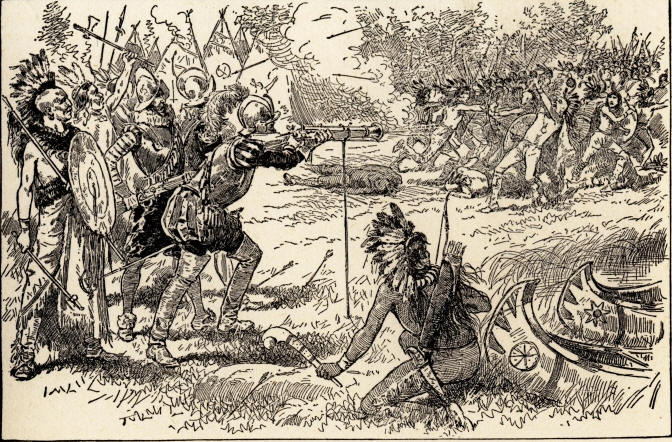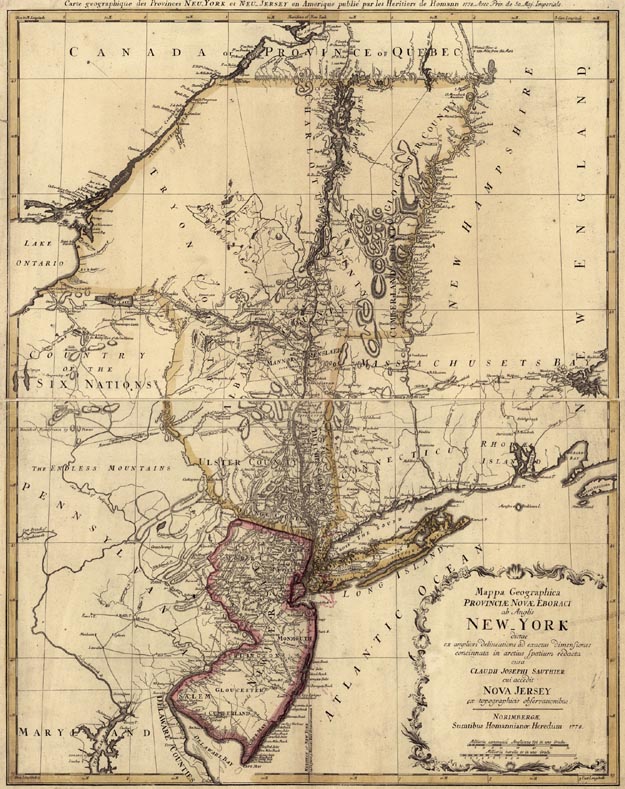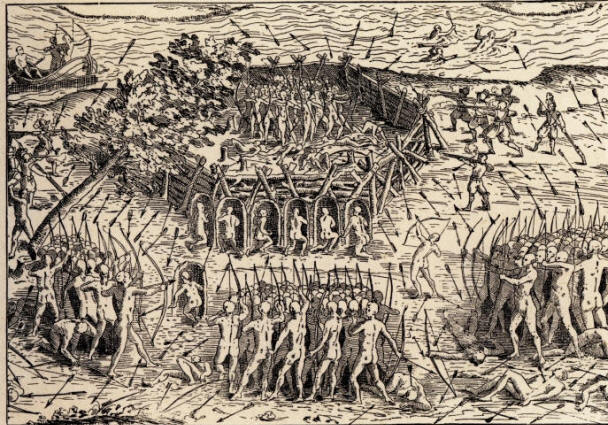Iroquois Confederacy
|
|
This Site:
|
The Mohawks, on the east, were called "the door." The confederacy embraced within its territory the present State of New York north and west of the Kaatzbergs and south of the Adirondack group of mountains. The several nations were subdivided into tribes, each having a heraldic insignia, or totem. Through the totemic system they maintained a tribal union, and exhibited a remarkable example of an almost pure democracy in government.
As each confederated union was divided into tribes, there were thirty or forty sachems in the league. These had inferior officers under them, and the civil power was widely distributed. Office was the reward of merit alone ; malfeasance in it brought dismissal and public scorn. All public services were compensated only by public esteem. The powers and duties of the president of the league were similar to those conferred and imposed upon the chief magistrate of our republic. He had authority to assemble a congress of representatives; had a cabinet of six advisers, and in the council he was a moderator. There was no coercive power, excepting public opinion, lodged anywhere. The military dominated the civil power in the league. The chiefs derived their authority from the people, and they sometimes, like the Romans, deposed civil officers. The army was composed wholly of volunteers, and conscription was impossible. Every able-bodied man was bound to do military duty, and he who shirked it incurred everlasting disgrace. The ranks were always full. The recruiting-stations were the war-dances. Whatever was done in civil councils was subjected to review by the soldiery, who had the right to call councils when they pleased, and approve or disapprove public measures. The matrons formed a third and powerful party in the legislature of the league. They had a right to sit in the councils, and there exercise the veto power on the subject of a declaration of war, and to propose and demand a cessation of hostilities. They were preeminently peace-makers. It was no reflection upon the courage of warriors if, at the call of the matrons, they withdrew from the warpath. These women wielded great influence in the councils, but they modestly delegated the duties of speech-making to some masculine orator. With these Indians, woman was man's co-worker in legislation - a thing unheard of among civilized people. So much did the Iroquois reverence the inalienable rights of man," that they never made slaves of their fellowmen, not even of captives taken in war. By unity they were made powerful; and to prevent degeneracy, members of a tribe were not allowed to intermarry with each other.
Champlain's Fight with the Iroquois IndiansLike the Romans, they caused their commonwealth to expand by annexation and conquest. Had they remained undiscovered by the Europeans a century longer the Confederacy might have embraced the whole continent, for the Five Nations had already extended their conquests from the Great Lakes to the Gulf of Mexico, and were the terror of the other tribes east and west. For a long time the French in Canada, who taught them the use of firearms, maintained a doubtful struggle against them. Champlain found them at war against the Canada Indians from Lake Huron to the Gulf of St. Lawrence. He fought them on Lake Champlain in 1609; and from that time until the middle of that century their wars against the Canada Indians and their French allies were fierce and distressing. They made friends of the Dutch, from whom they obtained firearms; and they were alternately at war and peace with the French for about sixty years. The latter invaded the cantons of the league, especially after the Five Nations became allied with the English, who, as masters of New York, used their dusky neighbors to carry out their designs. The Iroquois, meanwhile, carried their conquests almost to Nova Scotia on the east, and far towards the Mississippi on the west, and subdued the Susquehannas in Pennsylvania. In 1649 they subdued and dispersed the Wyandottes in the Huron country. Some of the fugitives took refuge among the Chippewas; others fled to Quebec, and a few were incorporated in the Iroquois Confederacy. The Wyandottes were not positively subdued, and claimed and exercised sovereignty over the Ohio country down to the close of the eighteenth century. Then the Five Nations made successful wars on their eastern and western neighbors, and in 1655 they penetrated to the land of the Catawbas and Cherokees. They conquered the Miamis and Ottawas in 1657, and in 1701 made incursions as far as the Roanoke and Cape Fear rivers, to the land of their kindred, the Tuscaroras. So determined were they to subdue the Southern tribes that when, in 1744, they ceded a part of their lands to Virginia, they reserved a perpetual privilege of a war-path through the territory. Map of the Six Nations of the Iroquois Confederacy from 1778A French invasion in 1693, and again in 1696, was disastrous to the league, which lost one-half of its warriors. Then they swept victoriously southward early in the eighteenth century, and took in their kindred, the Tuscaroras, in North Carolina, when the Confederacy became known as the Six Nations. In 1713 the French gave up all claim to the Iroquois, and after that the Confederacy was generally neutral in the wars between France and England that extended to the American colonies. Under the influence of William Johnson, the English Indian agent, they went against the French in 1755, and some of them joined Pontiac in his conspiracy in 1763. When the Revolution broke out, in 1775, the Iroquois, influenced by the Johnson family, adhered to the crown, excepting the Oneidas. Led by Brant and savage Tories, they desolated the Mohawk, Cherry, and Wyoming valleys. The country of the Western Iroquois, in turn, was desolated by General Sullivan in 1779, and Brant retaliated fearfully on the frontier settlements. At the close of the war the hostile Iroquois, dreading the vengeance of the exasperated Americans, took refuge in Canada, excepting the Oneidas and Tuscaroras.
ATTACK ON AN IROQUOIS FORT (From an old print) By treaties, all the lands of the Six Nations in New York passed into the possession of the white people, excepting some reservations on which their descendants still reside. In the plenitude of their power the Confederacy numbered about 15,000; they now number about 13,000, distributed at various points in Canada and the United States. In 1899 there were 2,767 Senecas, 549 Onondagas, 161 Cayugas, 270 Oneidas, and 388 Tuscaroras in New York State; 1,945 Oneidas in Wisconsin; and 323 Senecas in Indian Territory. Like the other Indians of the continent, the Iroquois were superstitious and cruel. They believed in witches as firmly as did Cotton Mather and his Puritan brethren in New England, and they punished them in human form as fiercely as Henry VIII., or the rulers and the Gospel ministers at Salem in later times. Their "medicine men" and "prophets" were as expert deceivers as the priests, oracles, and jugglers of civilized men. They tortured their enemies in retaliation for kindred slain with almost as refined cruelty as did the ministers of the Holy Inquisition the enemies of their opinions; and they lighted fires around their more eminent prisoners of war, in token of their power, as bright and hot as those kindled by enlightened Englishmen around Joan of Arc as a sorceress, or Bishops Latimer and Ridley as believers in what they thought to be an absurdity. |
|
|
||
|
|
Site Copyright 2003-2018 Son of the South. For Questions or comments about this collection, contact: paul@sonofthesouth.net |
|
|
Are you Scared and Confused? Read My Snake Story, a story of hope and encouragement, to help you face your fears. |
||
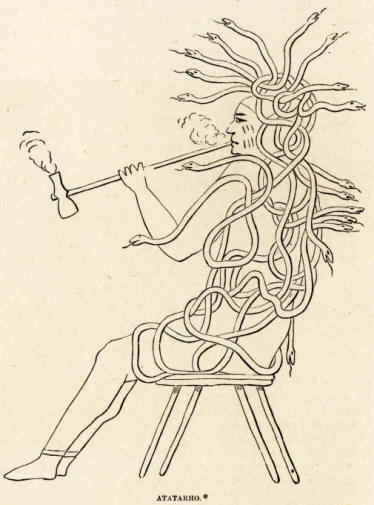 Iroquois
Confederacy, THE, was originally composed of five related
families or nations of Indians, in the present State of New York.
These were called respectively, Mohawks, Oneidas, Onondagas, Cayugas,
and Senecas. Tradition says the confederacy was founded by Hiawatha,
the incarnation of wisdom, at about the beginning of the fifteenth
century. He came from his celestial home and dwelt with the
Onondagas, where he taught the related tribes the knowledge of good
living. Fierce warriors approached from the north, slaying
everything human in their path. Hiawatha advised a council. It was
held on the bank of Onondaga Lake. Representatives of each nation
were there. Under his direction a league was formed, and each
canton was assigned its appropriate place in it. They gave it a name
signifying " they form a cabin," and they fancifully called the
league "The Long House." The eastern door was kept by the Mohawks,
and the western by the Senecas, and the council-fire was with the
Onondagas, at their metropolis, a few miles south of the site of the
city of Syracuse. By common consent, a chief of the Onondagas,
called Atatarho, was made the first president of the league.
Atatarho, the first president of the Iroquois
Confederacy, is represented by the Indians as living, at the time he
was chosen, in grim seclusion in a swamp, where his dishes and
drinking-vessels, like those of half-barbarian Caucasians, were made
of the skulls of his enemies slain in battle. When a delegation went
to him to offer him the symbol of supreme power, they found him
sitting smoking his pipe, but unapproachable, because he was
entirely clothed with hissing snakes. Here is the old story of
Medusa's snaky tresses unveiled in the forests of the newfound
world.
Iroquois
Confederacy, THE, was originally composed of five related
families or nations of Indians, in the present State of New York.
These were called respectively, Mohawks, Oneidas, Onondagas, Cayugas,
and Senecas. Tradition says the confederacy was founded by Hiawatha,
the incarnation of wisdom, at about the beginning of the fifteenth
century. He came from his celestial home and dwelt with the
Onondagas, where he taught the related tribes the knowledge of good
living. Fierce warriors approached from the north, slaying
everything human in their path. Hiawatha advised a council. It was
held on the bank of Onondaga Lake. Representatives of each nation
were there. Under his direction a league was formed, and each
canton was assigned its appropriate place in it. They gave it a name
signifying " they form a cabin," and they fancifully called the
league "The Long House." The eastern door was kept by the Mohawks,
and the western by the Senecas, and the council-fire was with the
Onondagas, at their metropolis, a few miles south of the site of the
city of Syracuse. By common consent, a chief of the Onondagas,
called Atatarho, was made the first president of the league.
Atatarho, the first president of the Iroquois
Confederacy, is represented by the Indians as living, at the time he
was chosen, in grim seclusion in a swamp, where his dishes and
drinking-vessels, like those of half-barbarian Caucasians, were made
of the skulls of his enemies slain in battle. When a delegation went
to him to offer him the symbol of supreme power, they found him
sitting smoking his pipe, but unapproachable, because he was
entirely clothed with hissing snakes. Here is the old story of
Medusa's snaky tresses unveiled in the forests of the newfound
world.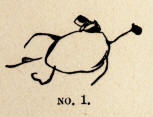 Each canton or nation was a distinct republic,
independent of all others in relation to its domestic affairs, but
each was bound to the others of the league by ties of honor and
general interest. Each had an equal voice in the general council or
congress, and possessed a sort of veto power, which was a guarantee
against despotism. After the Europeans came, the sachem, or civil
head of a tribe, affixed his totem-such as the rude outlines of a
wolf, a bear, a tortoise, or an
Each canton or nation was a distinct republic,
independent of all others in relation to its domestic affairs, but
each was bound to the others of the league by ties of honor and
general interest. Each had an equal voice in the general council or
congress, and possessed a sort of veto power, which was a guarantee
against despotism. After the Europeans came, the sachem, or civil
head of a tribe, affixed his totem-such as the rude outlines of a
wolf, a bear, a tortoise, or an
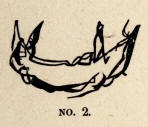 eagle-to every public paper he was
required to sign. It was like a monarch affixing his seal. Each of
the original Five Nations was divided into three tribes, those of
the Mohawks being designated as the Tortoise or Turtle, the Bear,
and the Wolf. These totems consisted of representations of those
animals. These were sometimes exceedingly rude, but were sufficient
to denote the tribe of the signer ; as, No. 1, appended to the
signature of Little Hendrick, a Mohawk chief, represents his totem -
eagle-to every public paper he was
required to sign. It was like a monarch affixing his seal. Each of
the original Five Nations was divided into three tribes, those of
the Mohawks being designated as the Tortoise or Turtle, the Bear,
and the Wolf. These totems consisted of representations of those
animals. These were sometimes exceedingly rude, but were sufficient
to denote the tribe of the signer ; as, No. 1, appended to the
signature of Little Hendrick, a Mohawk chief, represents his totem -
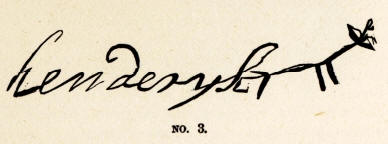 a turtle;
No. 2, appended to the signature of Kanadagea, a chief of the Bear
tribe, represents a bear lying on his back; and No. 3 is the
signature of Great Hendrick, of the Wolf tribe, the rude
representation of that animal appearing at the end of his signature.
a turtle;
No. 2, appended to the signature of Kanadagea, a chief of the Bear
tribe, represents a bear lying on his back; and No. 3 is the
signature of Great Hendrick, of the Wolf tribe, the rude
representation of that animal appearing at the end of his signature. 